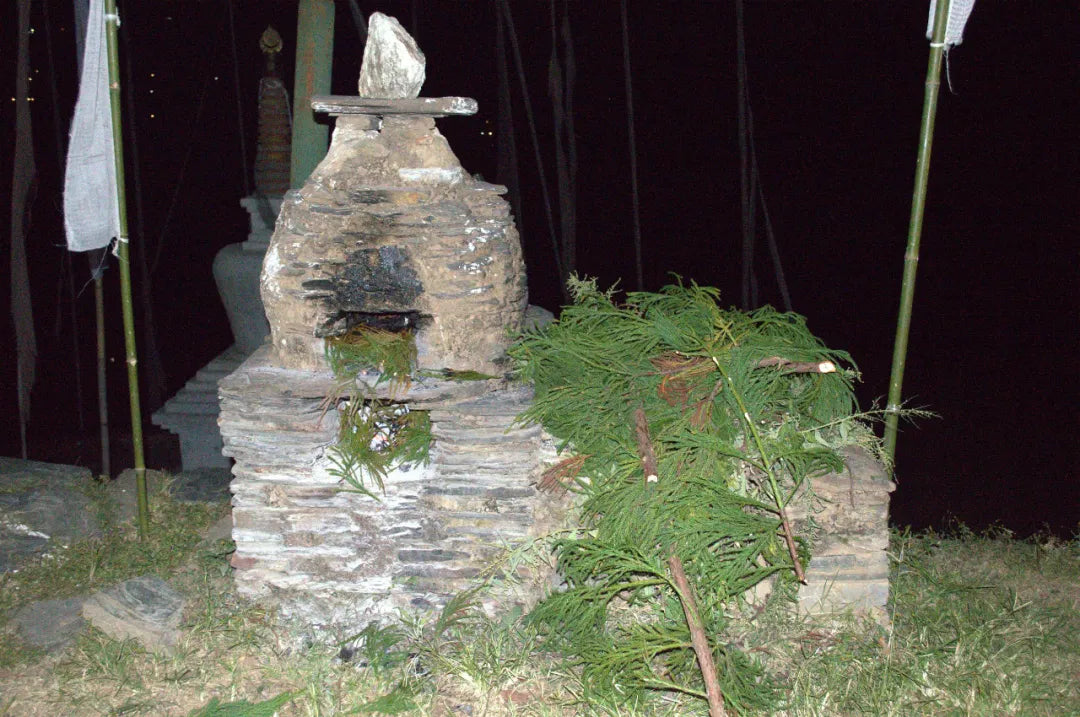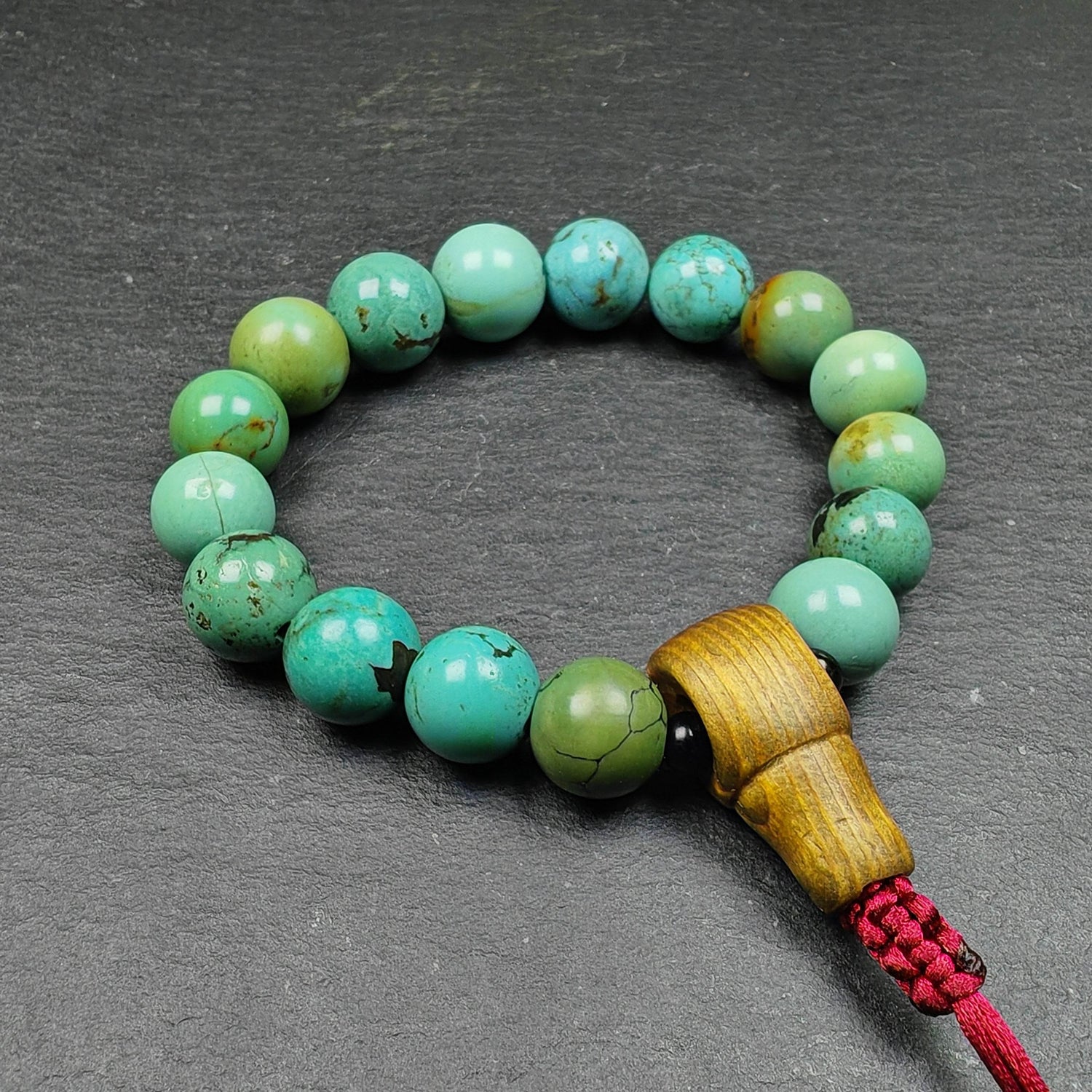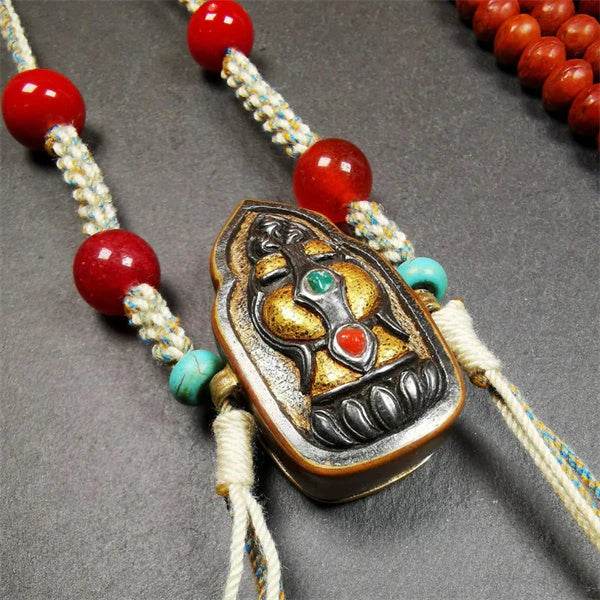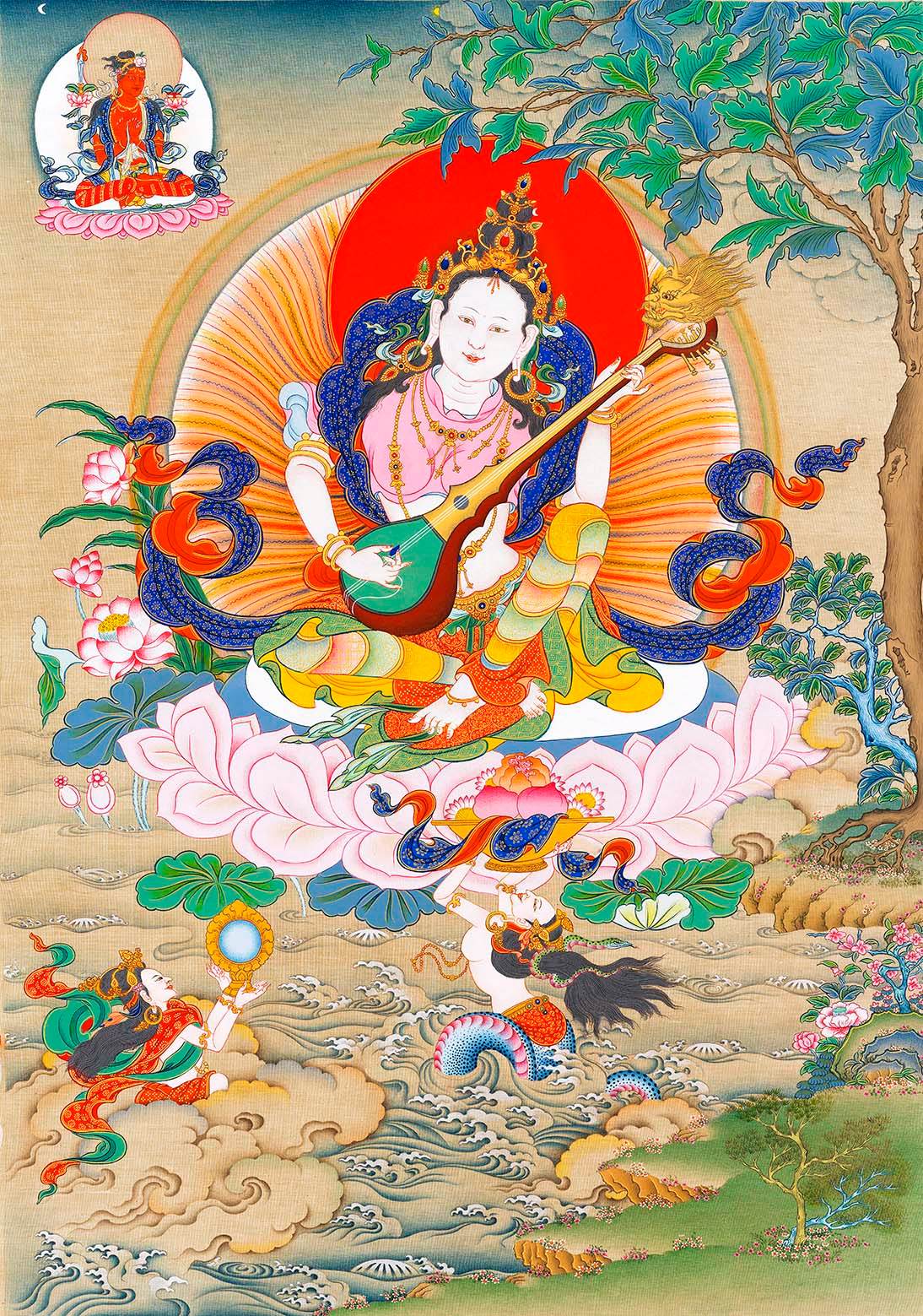
Journey Through the Fragrance of Tibet: Hometown Cypress and Pine

"Biographical Illustrations of Tonpa Shenrab, the Founder of Bon: Middle Age"
Mid-19th Century, Rubin Museum Collection
Detail: Preaching the Dharma to Non-Human Devotees Amidst a Cypress Forest

"The Ancestral Monastery of Bon: Menri Monastery"
Photographed by Michael Henss, from "Cultural Relics of Tibet"
Ancient texts recount that during the construction of the monastery, the mountain was covered with "sacred trees - green-needled cypresses."
Using cypress branches for incense offerings, deities from heaven, earth, and the mortal realm gathered and bestowed blessings.

"Morning Incense Offering in the Bhutanese Royal Palace"
Photographed by Professor Michael Aris in 2012
Held in the Pitt Rivers Museum Collection
དེར་ས་མ་བུ་ཚངས་པོ་དག། ཀླུང་མ་བུ་ཚངས་པོ་དག།
གཉན་སྡེ་བཞི་ཚངས་པོ་དག། ནམ་མཁའི་ལྷའི་ཚངས་པོ་དག།
མ་དག་པ་རྣམས་དག་པ་མདོས། ཕྱིར་ལྟས་ན་ནང་གསལ་བ།
ནང་ལྟས་ན་ཕྱིར་གསལ་བ།
ཤེལ་སྒོང་གི་གྱའ་བྱིས་པར་བཞིན་དུ་མདོས་ཅིག།
May the vast earth be immaculate, may the mountains and rivers be immaculate,
May the four clans of thought be immaculate, may the celestial deities be immaculate,
May all impurities be purified, pure from the outside looking in,
Pure from the inside looking out, as clear as a crystal bead.
Excerpt from the Bon scripture *The Fox Smoke Offering Ritual* (ཝའི་བསང་།)
A handwritten smoke offering text originating from a Bon monastery.
**[Note 1]**: The term "fox" in the title has multiple interpretations.
Some say fox fur was used in smoke offerings, others claim the fox is a messenger of the gods,
While some argue that "fox" here should not be understood literally as the animal.
**[Note 2]**: The term "ཀླུང་།" in the text is generally understood to mean mountains, rivers, and regions.
However, some scholars believe it is a scribal error and should instead be "ཀླུ་" (lu, serpent spirits).
If so, the smoke offering corresponds to the celestial deities (lha), subterranean lu spirits, and earthly nyen spirits,
With nyen often manifesting as mountain and lake deities.

"Portrait of the Second Shamarpa, Khachö Wangpo, Making Offerings to the Mountain Deities"
Mid-19th Century, Rubin Museum Collection
Detail: White smoke rising in wisps from a burning incense burner.

"Biographical Illustrations of Padmasambhava"
Mid to Late 17th Century, Private Collection
Detail: Practicing in the snow-capped mountains and caves of Tibet, and concealing terma (hidden treasures).
The terma tradition holds that the earliest smoke offering texts in Tibet originated from Padmasambhava.
During the Tibetan Empire period, a legend tells of two families experiencing a peculiar calamity. A man from one family killed a relative and then committed suicide, his restless soul transforming into a vengeful spirit that began tormenting a pregnant woman in the household. In ancient Tibetan texts unearthed in Dunhuang and in the folk cultures of certain regions today, a person who kills a clan member or relative, regardless of gender, is referred to as *dri chen* (དྲི་ཅན་). When such individuals become vengeful spirits, males are called *dri bo* (དྲི་བོ་) and females *dri mo* (དྲི་མོ་). It is worth noting that another set of terms exists: male perpetrators may also be called *me bo* (དམེ་བོ་), and females *me mo* (དམེ་མོ་). Because they bear the weight of having taken a relative's life, these spirits carry an indescribable stench. Without performing specific rituals to dispel the curse, it is highly likely that the newborn child in the family would not survive. To address this, the parents of the child invited nine *bonpo* (priests or ritual specialists from the indigenous religion) to conduct ceremonies to summon deities and remove the curse. Three *torma* (གཏོར་མ་; ritual offering cakes) were arranged: one on the left for the deities, one on the right for the spirits, and one in the center for the ancestral and territorial deities. Additionally, the two families presented offerings of a goat's head, alcohol, *tsampa* (or flatbread), butter, gold and silver treasures (usually coins or turquoise), and an arrow adorned with colored silk. Throughout the ritual, *sang* (བསང་; smoke purification) was continuously performed to welcome the deities. Amidst the swirling smoke, the impurity arising from *me* (དམེ་; kin-slaying) was cleansed.
The impurity of kin-slaying is one of the "nine impurities" (such as intra-clan marriage and widowhood) in the indigenous religious tradition, and it must be purified through *sang* (བསང་མཆོད་; smoke offering). Although both *sang* and incense burning (སྤོས་སྤར་) are pillars of Tibetan aromatic culture, they differ in origin and form. Descriptions of *sang* emphasize the act itself and the theory of internal and external relationships (with a focus on indigenous origins), while descriptions of incense burning focus on the composition/formula of the incense and the blessings it generates, as well as the universal practices of Buddhism (influenced more by South Asian offering traditions). Therefore, except for some Bon scriptures and terma texts like *The Sacred Blue Water* (see the first article in this series), most *sang* texts do not provide detailed material lists. In contrast, numerous incense-making texts (སྤོས་སྦྱར་) list recipes from various lineages (such as the Nagarjuna lineage, Atisha lineage, and Kashmiri master lineage) and their ingredients (mostly foreign aromatic substances). Discussing the materials used in *sang* is essentially exploring the indigenous aromatic system, i.e., the pre-Buddhist guide to using aromatic substances in Tibet.

"Bon Tradition Thangka: The Great Master Ame Chhenpo"
Mid-14th Century, Collection of Navin Kumar
Note: Within the Bon tradition, there are legends about obtaining the finest materials for *sang* (smoke purification) rituals.

"Portrait of the Third Karmapa, Rangjung Dorje"
Mid-15th Century, Private Collection
His work, *The Universal Smoke Offering Ritual* (འཛམ་གླིང་སྤྱི་བསང་།),
Is regarded as the first significant smoke offering text composed by a native Buddhist scholar,
And it established the enduring tradition of the "Universal Sang Offering Day" celebrated to this day.

"Thangka of Tibetan Medicine from the Blue Beryl: Essences of Earth and Wood, and Medicinal Herbs of the Plains"
Early 20th Century, Collection of the Lhasa Men-Tsee-Khang
Detail: A juniper tree from the cypress family, specifically *Juniperus tibetica* (ཤུག་ཚེར་).

"Thangka of Tibetan Medicine from the Blue Beryl: Essences of Earth and Wood, and Medicinal Herbs of the Plains"
Early 20th Century, Collection of the Lhasa Men-Tsee-Khang
Detail: A fir tree from the pine family, specifically *Abies spectabilis* (གསོམ་ཤིང་།).
Materials used for *sang* (smoke purification) are generally divided into two categories: *sang* trees/branches (བསང་ཤིང་།) and *sang* substances (བསང་རྫས་). Among these, the most important *sang* tree is the juniper (ཤུག་པ་). The lush juniper, with its branches broken and burned, and the birds flying above it, together symbolize prosperity. In the indigenous context, the juniper is also referred to as the divine tree (ལྷ་ཤིང་།), the cosmic/world tree (སྲིད་ཤིང་།), or the branch of radiance (འོད་ཟེར་འདབ་ཅན་). This tree is one of the "four eternal symbols" in Bon (symbolizing the source of all things), with deities temporarily resting atop its branches. Its leaves are said to be of two types: golden and turquoise (though some classifications mention three or four types). Before the birth of Tonpa Shenrab, the founder of Bon, a blue cuckoo was said to circle above a juniper tree. Many Bon monasteries and sacred sites, which are considered auspicious, were built in places where "turquoise-needled junipers flourished in groves." It is worth noting that the indigenous reverence for juniper trees even influenced the construction of Buddhist historical narratives, as seen in the origin story of Reting Monastery (detailed in the first article of this series). Common juniper species used for *sang* in Tibet include *Juniperus tibetica*, *Juniperus pingii*, *Juniperus recurva*, and *Juniperus saltuaria*, among others. Although preferences vary by region, the enthusiasm for juniper remains strong, as its fragrance is believed to purify all impurities and calm the deities and spirits residing within people, alleviating their anger and unease. Notably, *sang* substances are now classified into seven types: grain *sang* (commonly *tsampa*), medicinal *sang*, fur *sang* (such as yak or sheep wool), floral *sang*, liquid *sang* (such as pure water or alcohol), silk *sang*, and precious *sang*. This highlights that, unlike incense burning and perfumery, *sang* emphasizes a functional relationship centered on "cleansing impurities."
In addition to juniper, other commonly used *sang* trees/branches include:
1. **Pine family plants**, such as *Abies spectabilis*, *Picea likiangensis var. linzhiensis*, *Pinus densata*, *Pinus bungeana*, and *Cupressus torulosa*. In classical texts, pine and juniper are collectively referred to as *thang shug* (ཐང་ཤུག་), with juniper symbolizing the source of all things and pine representing enduring vitality. The resin (ཐང་ཆུ་) on pine trees is aromatic, and the black smoke produced when burned is believed to pacify the *tsen* spirits roaming the world.
2. **Rhododendron family plants**, such as *Rhododendron anthopogon*, *Rhododendron cephalanthum*, *Rhododendron laudandum*, and *Ledum palustre*. Speechlessness, immobility, and mental stagnation are often associated with the pollution of wisdom deities. Using rhododendron plants for *sang* is believed to calm and purify these wisdom deities.
3. **Aster family plants**, such as various species of *Artemisia* (e.g., wild mugwort, *མཁན་པ་*). When local deities are polluted, disasters become frequent, crops fail, and people and livestock suffer. Using these plants for *sang* is thought to purify the local deities (གཞི་བདག་; territorial spirits), and classical texts often pair them with juniper as *mkhan shug* (མཁན་ཤུག་).
Beyond these commonly used *sang* trees, different regions of Tibet have their own unique *sang* plants, each with its own origin stories. For example, in the Lhoka region, peach trees (specifically *Prunus mira*; discussed in earlier articles on fruits) are used for *sang*, and the region's rich historical and cultural heritage provides numerous interpretations, such as the legend of the Yarlung fruit trees during the Tibetan Empire period.

"Thangka of Tibetan Medicine from the Blue Beryl: Supplementary Medicinal Substances"
Early 20th Century, Collection of the Lhasa Men-Tsee-Khang
Detail: Spikenard (སྤང་སྤོས་), revered as the "fragrant source of the earth."

"Thangka of Tibetan Medicine from the Blue Beryl: Supplementary Medicinal Substances"
Early 20th Century, Collection of the Lhasa Men-Tsee-Khang
Detail: Rhododendron anthopogon (བ་ལུ་དཀར་པོ་; on the left), a member of the rhododendron family.

"Thangka of Tibetan Medicine from the Blue Beryl: Supplementary Medicinal Substances"
Early 20th Century, Collection of the Lhasa Men-Tsee-Khang
Detail: Pine resin/pine oil (ཤེལ་ཏ་; on the left), derived from the pine family.
Sandalwood (purifying the impurities of celestial deities), birch (སྟག་པ་ཤིང་།; purifying the impurities of ancestral and clan deities), pine, and juniper—while embracing foreign aromatic influences, Tibet's indigenous fragrance culture has retained its original charm. In addition to today's article on native aromatic substances, the author has previously explored the status and symbolic meanings of common aromatics such as sandalwood, agarwood, musk, saffron, myrrh, cardamom, and frankincense in Tibetan fragrance culture. Earlier articles also provided a concise overview of Tibetan incense-making techniques. As the concluding piece of the "Journey Through the Fragrance of Tibet" series, the author will present a comprehensive summary of the historical and material aspects of Tibetan aromatic culture. Stay tuned! May auspicious fragrances endure in this world!

"Pagoda-shaped Sang Offering Platform and Sang Vegetation"
Photographed by Sherig Dentshog in 2014.







2 commentaires
ocbb09
JddS xhcI tapTxde LrERpRK